When I’m not sewing I like painting furniture, although it is a not as relaxing an activity as embroidery and needs rather more preparation. This chest of drawers was originally made for a bedroom but when we moved house, the only place it fitted into was the dining room. Cool broad blue stripes were exchanged for a lipstick red background to no disadvantage at all, especially in the evening with side lights on. I like the idea of a coral red room but experience has taught me that the only place it doesn’t oppress me is in the dining room. Even so, every so often I look at the walls, cower, twitch and consider reaching for a pot of creamy yellow paint. What I do love is the odd piece of furniture gold on black with a hint of Pompeian red. Chinoiserie would be spot on but expensive. So, failing that a couple of pots of ferns, a tin of matt red paint, a few cans of matt gold and matt black paint thrown at an ordinary couple of chests of drawers just about satisfy me.
Ferns collected and pressed make unique stencils, each frond differing in shape and size if a single plant is used. The long pinnate fronds are Dryopteris, whilst the more frothy Adiantum is immediately recognisable as the maidenhair fern. The only book big enough to press the longest leaves in was an atlas and by the time it was interleaved with the rather surprisingly large amount of foliage needed to decorate the chest of drawers (including sheets of paper on either side of the leaves to ensure future legibility of the atlas), the atlas was almost twice its usual thickness. Permanent ruin was probably always inevitable. It is perhaps fortunate that world geography is not a static study and that expenditure on a new atlas in the interest of keeping abreast of the times could be fully justified.
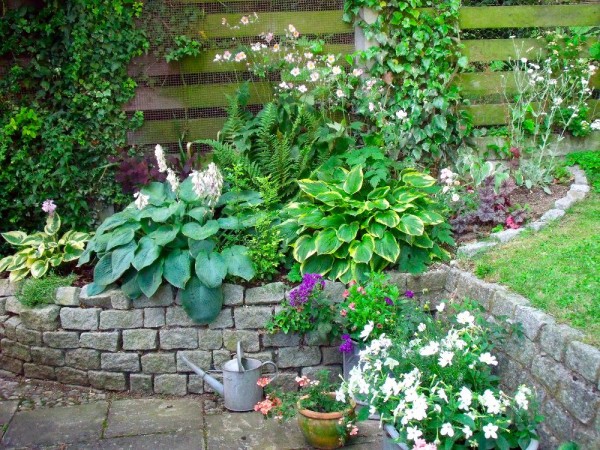
Dryopteris fern in the vicarage garden just about holding its own with flourishing hostas and Japanese anemones
While the leaves are being pressed, the chest of drawers can be prepared. My chest came with primer already applied but it still needed a light sanding before and in between two coats of red undercoat. The entire chest was then sprayed with gold spray paint – not especially evenly as I wanted some of the red beneath to be visible. Working quickly, I then sprayed the leaves with spray adhesive and positioned them where I thought they looked good. When I was satisfied with the arrangement, I sprayed the whole thing, leaves and all, with black paint, being careful not to spray any one area too heavily so that the paint would run. It is better to give a light spray, then spray somewhere else before going back to areas where the black is too patchy. Panic sets in at this point as the whole thing looks like it has some dreadful skin disease. Do not worry, patchiness is not particularly noticeable once the gold leaves are revealed. However, this must be done as quickly as possible as the spray adhesive seems to do its job only too well and the danger is the leaves remain firmly fixed. When all leaves are removed (and, truth to tell, a few bits do remain but most eventually curl up and can be piggled off) the whole thing could then be given a light matt varnish, but I didn’t do this because I quite like to see signs of wear and I don’t like the look varnish gives painted furniture.
I’ve always fancied having a fernery or a stumpery in the garden. I think that’s in part because of the name which to me summons up a vision of a sort of outdoor boudoir (and I’ve always rather fancied an indoor one of those too) – somewhere to go to where you could be grumpy (or perhaps stumpy) in a calming green environment where the spirits can be lifted. The boudoir is the place you go to to sulk (from the french bouder: to sulk) although in practice it was more often used as an evening retiring room or the place you went to do your embroidery or play a game of cards. John Jarndyce in ‘Bleak House’ had his growlery, which he explains is his retreat for times of ill humour. (Note: men are ill humoured; women sulk).
The stumpery to end all stumperies is probably that developed at Highgrove for the Prince of Wales by Julian and Isabel Bannerman. After creating a small fernery for him they moved on to a fully fledged stumpery, designed around a well established oak tree. Far from being content to use only stumps, this garden is as virtuoso a performance in dead and dying wood as you could ever wish to see. Baroque arches spanning woodland paths on closer examination are revealed to be old sweet chestnut stumps upside down and with roots waving in the air like so many Laocoon family groups. Two little temples, seemingly stone but actually wood, have pillars made of green oak sandblasted to look like stone. Steel backbones support weathering wood in one place while elsewhere wood is encouraged to rot down to provide a micro-environment for insects and other small woodland creatures. The oak temple idea was the genius response to keeping costs down. Recycling of the grandest sort was employed in the Gunnera (a giant rhubarb-like plant) Fountain where the reclaimed stone came from Gloucester Cathedral while giant clam shells were turfed out of the cellar at Sandringham. Gosh.
The Bannermans created their own stumpery at their home Hanham Court. (The house was sold last year but the new owners are still opening it to visitors.) Ferns, sweet chestnut stumps and holey stones surround a pool from which, every hour, a golden crown is carried up high on a jet of water – a Renaissance water joke , as delightful now as ever it was.
Victorian ladies may have confined their ferns to Wardian boxes on the window sills or to clammy bits of damp land where the sun never reached and there may even have been some glorious Victorian glass houses raised to house the expensive products of past hunting expeditions. However today the fernery seems to have been taken to new heights of creativeness and completely reinvented by designers of flair and imagination. Oh, if only I had some wonderful abandoned piece of stonework languishing in my cellar – or for that matter if only I had a cellar. Still, I do at least have 2 lovely ferns in the vicarae garden and I think I shall start adding to them in the shady bed beneath the beech trees where, so far, nothing much wants to flourish.
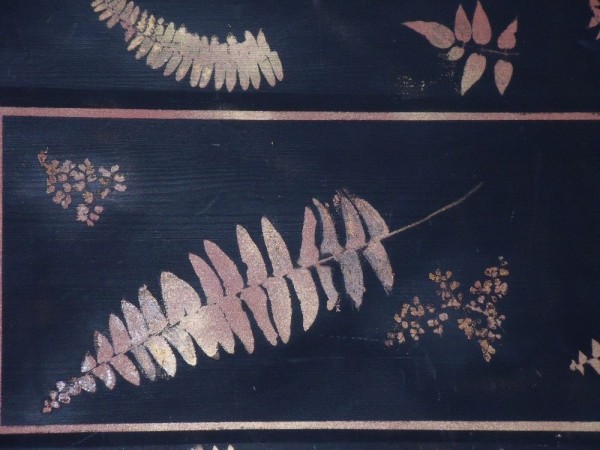
Fern chest of drawers: detail of front, showing both Dryopteris and Adiantum (Maidenhair fern) ferns

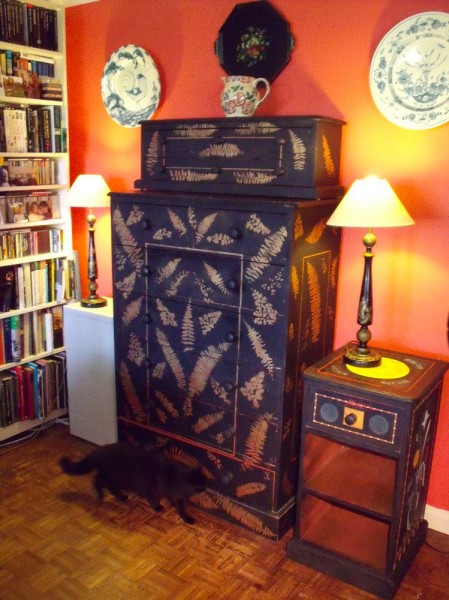
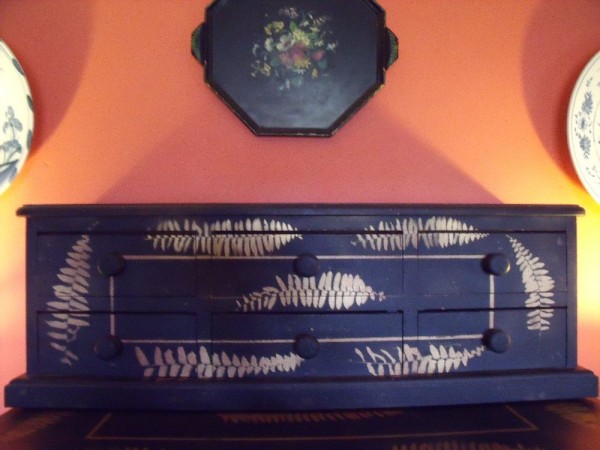
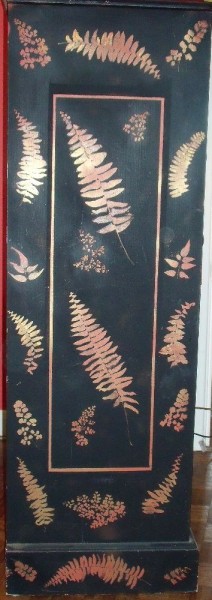
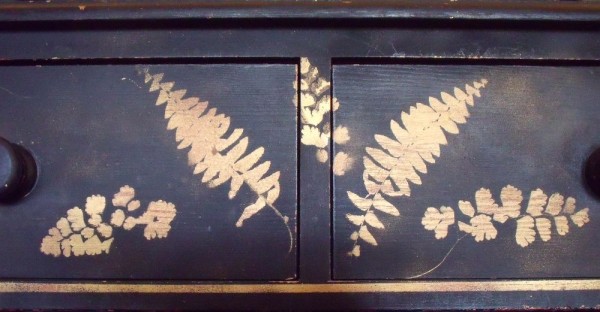
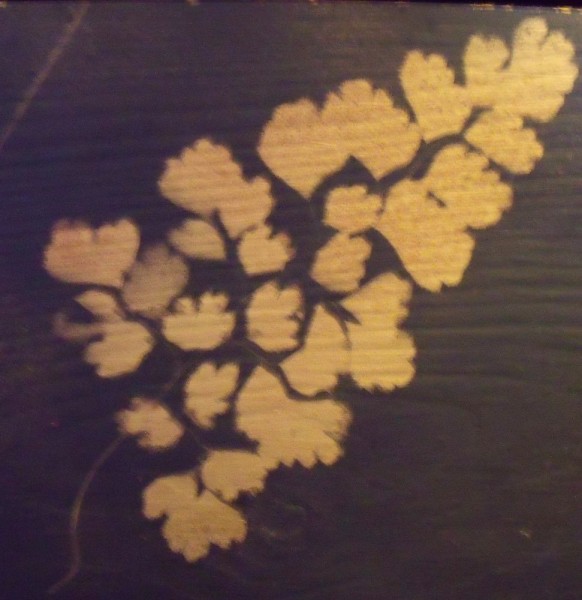
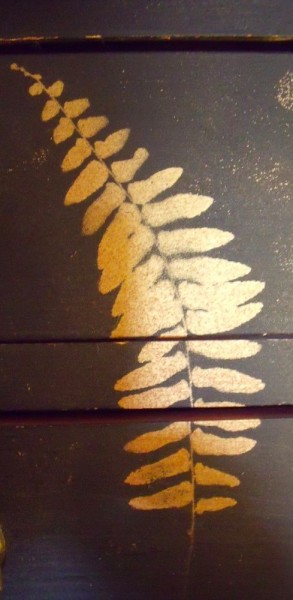
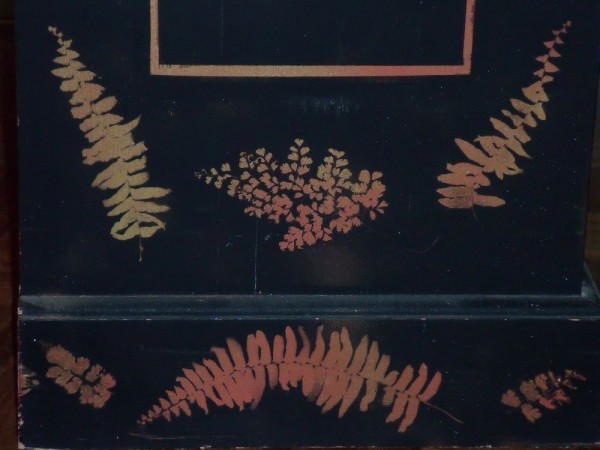
2 Comments
Your website is just amazing! What a treat, I just feel like setting aside a moment every day to endulge in half an hours reading and thought. I love how you can incorporate so many different topics, all linked, all interesting, even to those who know nothing about them. Its beautifully and thoughtfully written and an absolute inspiration, very well done. Liz x
Liz,
Sorry not to have thanked you for your kind comment earlier.
It’s always good to hear such nice things.
Mary
2 Trackbacks
[…] a black chest of drawers – perhaps you remember the post from August 2012 which can be read here. Since I wrote that piece I have visited Highgrove House, the prince of Wales’s house and […]
[…] like ferns so much I used leaves as stencils when I repainted a chest of drawers and blogged about here. It might also seem from this photograph that the walls are painted Le Creuset orange. In fact they […]